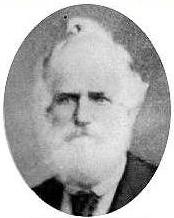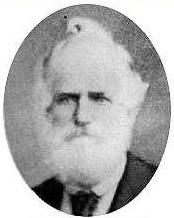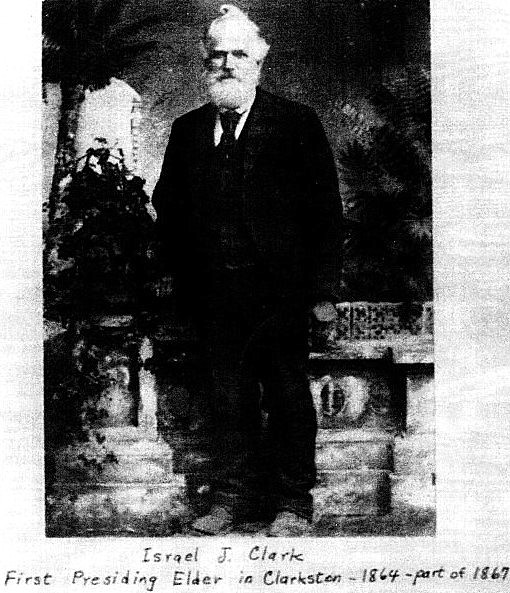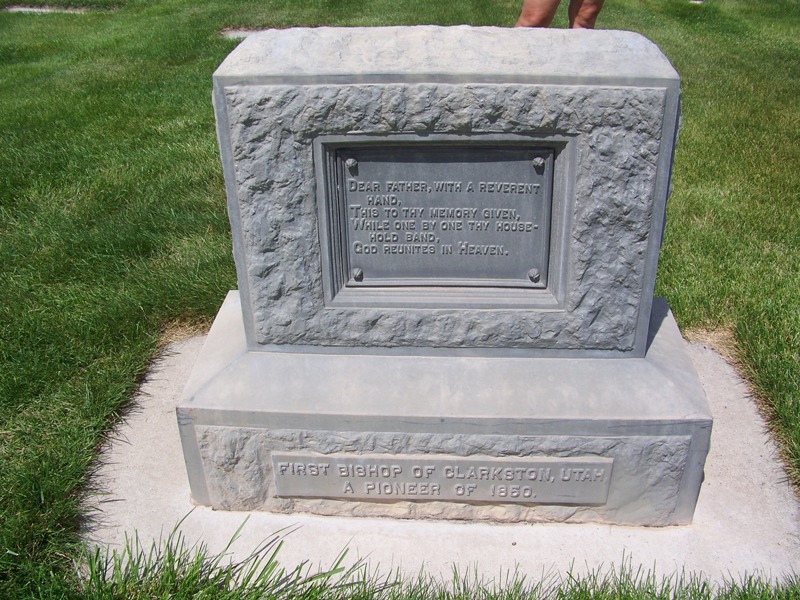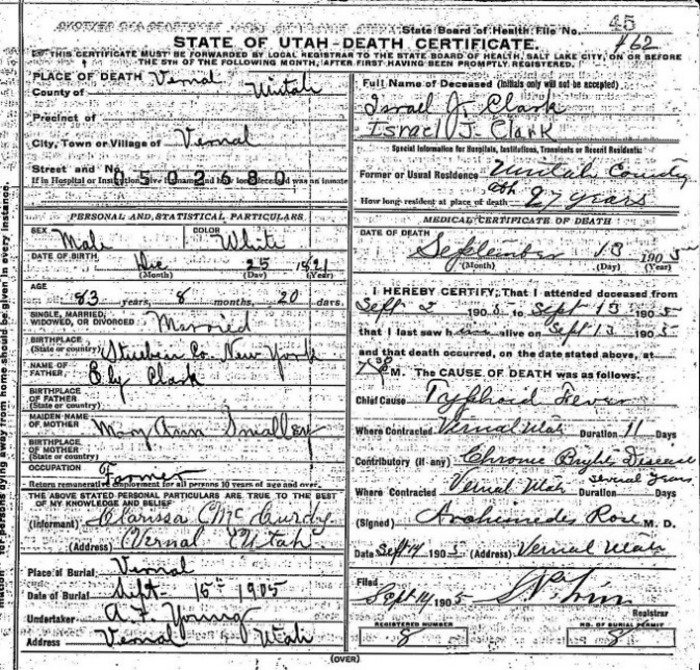Married Elizabeth Angeline Tuttle, 1839, Ossian, Allegany, New York
Married Louisa Eynon, 24 Nov 1851, Nauvoo, Hancock, Illinois
Married Emily Jane Pearson, 24 Jan 1853, Salt Lake City, Salt Lake, Utah
History - Israel was seven years old when his father died leaving a large family. His oldest brother who now managed the farm was a hard working severe man, he gave his younger brother little time off even for school.
When Israel was 13 years of age he worked for a carpenter who had a turning lathe and they made chairs. He went with the carpenter down the river on a flat boat to deliver the chair to a merchant. The merchant wanted the chairs painted and Israel gladly took the job. From then on he was on his own and never saw his family again.
He joined the Church of Jesus Christ of Latter-Day Saints March 9, 1844 at Osian, Alleghany, New York at the age of 23, he came to Utah with the John Smith Co., in 1848, settling in the Salt Lake Valley. He was ordained an Elder December 10, 1848.
Israel Justice was truly a pioneer, an outstanding colonizer and builder, a great missionary to the Lamanite assisting in the settling of Fort Lemhi in the Salmon River country of Idaho in the early 50's. He was an Indian interpreter and an Indian War veteran. He worked with the Nez Perce, Blackfoot and the Shoshone of the Northwest. He was also great friends of the Indians of the Northern Utah and Utes of the Uintah Reservations. He could speak their language perfectly.
He was some of the original pioneers of Logan Utah, camping on the Little Logan River in 1859. They moved to Clarkston, Utah in 1867 and was the first bishop of this ward, Clarkston was named in his honor. They returned to Logan in 1871. He was called on a second mission October 11, 1875, laboring with the Lamanites in the vicinity in Corrinne, Utah, then a part of an Indian Reservation.
Israel had a wonderful personality. He was 6 ft. tall and walked straight as an arrow. His hair was auburn in color when he was young, but turned white early in life. His keen blue eyes could look an Indian down, yet twinkled when talking to a child. His voice was clear as a bell and could be heard a long distance. When he came to Ashley Valley he would stand outside his door and call to his neighbors half a mile away, "Bartlett, Ashton, Henry, get your teams the ditch has broken.
He came to Ashley Valley in the Fall of 1877 with his family, food and implements over the road from Heber that was little more than a trail crossing Daniels Creek many times. They entered Ashley Valley through the gap at the west. He and his sons were soon in the mountains getting logs and poles for house and fences on their homestead southeast of Vernal.
More and more people were coming to the valley and Indians came too. In the Fall of 1879 after the Meeker Massacre, his friends, the three chiefs of the Uintas came in the night and told him to get his people into the fort for safety. This was done at once. Many times he fed his Indian friends at their table and kept them while they jerked their meat and tanned their hides.
On May 1st, Israel started to Geber City for flour. When he got to Current Creek he encountered snow. He had to leave his teams (four horses and one wagon) on Red Creek, and went the rest of the way to Heber City on foot. He arrived in Heber on Saturday May 14th. He was in a helpless condition, he was forty miles from his teams, and on the day he reached Heber City there was four feet of snow on top of the Strawberry Mountain. Before he could return to Duchesne, Lake Fork and Uintah, streams rose and he could not get back home until the 4th of July.
When Uintah Stake was organized in 1886, he was chosen as the first high councilman. On May the 29th, 1905 he was ordained a patriarch, he was indeed a patriarch at heart and looked much like a prophet.
His carpenter trade was put to good use in Ashley Valley, as he made most of the coffins there. The first was for Mrs. Joseph Black, the first person to die in Ashley Valley, and the first to be buried in Vernal Memorial Park.
Helping to build churches, school houses, and furniture was his specialty. He was blind for a number of years before he died on Sept. 13 1905 in Vernal, and is buried in the Vernal Memorial Park.
Israel Justice Clark is recalled with gratefulness by the members of the Clarkston Ward, Vernal and Ashley Valley. He was an organizer and a spiritual leader, he has left us many inspiring testimonies. He was truly a pioneer who battled and overcame opposing forces. He gave freely of all he possessed to his fellow men and left us a rich heritage.
Married Elizabeth Angeline Tuttle, 1839, Ossian, Allegany, New York
Married Louisa Eynon, 24 Nov 1851, Nauvoo, Hancock, Illinois
Married Emily Jane Pearson, 24 Jan 1853, Salt Lake City, Salt Lake, Utah
History - Israel was seven years old when his father died leaving a large family. His oldest brother who now managed the farm was a hard working severe man, he gave his younger brother little time off even for school.
When Israel was 13 years of age he worked for a carpenter who had a turning lathe and they made chairs. He went with the carpenter down the river on a flat boat to deliver the chair to a merchant. The merchant wanted the chairs painted and Israel gladly took the job. From then on he was on his own and never saw his family again.
He joined the Church of Jesus Christ of Latter-Day Saints March 9, 1844 at Osian, Alleghany, New York at the age of 23, he came to Utah with the John Smith Co., in 1848, settling in the Salt Lake Valley. He was ordained an Elder December 10, 1848.
Israel Justice was truly a pioneer, an outstanding colonizer and builder, a great missionary to the Lamanite assisting in the settling of Fort Lemhi in the Salmon River country of Idaho in the early 50's. He was an Indian interpreter and an Indian War veteran. He worked with the Nez Perce, Blackfoot and the Shoshone of the Northwest. He was also great friends of the Indians of the Northern Utah and Utes of the Uintah Reservations. He could speak their language perfectly.
He was some of the original pioneers of Logan Utah, camping on the Little Logan River in 1859. They moved to Clarkston, Utah in 1867 and was the first bishop of this ward, Clarkston was named in his honor. They returned to Logan in 1871. He was called on a second mission October 11, 1875, laboring with the Lamanites in the vicinity in Corrinne, Utah, then a part of an Indian Reservation.
Israel had a wonderful personality. He was 6 ft. tall and walked straight as an arrow. His hair was auburn in color when he was young, but turned white early in life. His keen blue eyes could look an Indian down, yet twinkled when talking to a child. His voice was clear as a bell and could be heard a long distance. When he came to Ashley Valley he would stand outside his door and call to his neighbors half a mile away, "Bartlett, Ashton, Henry, get your teams the ditch has broken.
He came to Ashley Valley in the Fall of 1877 with his family, food and implements over the road from Heber that was little more than a trail crossing Daniels Creek many times. They entered Ashley Valley through the gap at the west. He and his sons were soon in the mountains getting logs and poles for house and fences on their homestead southeast of Vernal.
More and more people were coming to the valley and Indians came too. In the Fall of 1879 after the Meeker Massacre, his friends, the three chiefs of the Uintas came in the night and told him to get his people into the fort for safety. This was done at once. Many times he fed his Indian friends at their table and kept them while they jerked their meat and tanned their hides.
On May 1st, Israel started to Geber City for flour. When he got to Current Creek he encountered snow. He had to leave his teams (four horses and one wagon) on Red Creek, and went the rest of the way to Heber City on foot. He arrived in Heber on Saturday May 14th. He was in a helpless condition, he was forty miles from his teams, and on the day he reached Heber City there was four feet of snow on top of the Strawberry Mountain. Before he could return to Duchesne, Lake Fork and Uintah, streams rose and he could not get back home until the 4th of July.
When Uintah Stake was organized in 1886, he was chosen as the first high councilman. On May the 29th, 1905 he was ordained a patriarch, he was indeed a patriarch at heart and looked much like a prophet.
His carpenter trade was put to good use in Ashley Valley, as he made most of the coffins there. The first was for Mrs. Joseph Black, the first person to die in Ashley Valley, and the first to be buried in Vernal Memorial Park.
Helping to build churches, school houses, and furniture was his specialty. He was blind for a number of years before he died on Sept. 13 1905 in Vernal, and is buried in the Vernal Memorial Park.
Israel Justice Clark is recalled with gratefulness by the members of the Clarkston Ward, Vernal and Ashley Valley. He was an organizer and a spiritual leader, he has left us many inspiring testimonies. He was truly a pioneer who battled and overcame opposing forces. He gave freely of all he possessed to his fellow men and left us a rich heritage.
Family Members
-
![]()
Jesse Tuttle Clark
1840–1918
-
![]()
James Israel Clark
1841–1909
-
![]()
Cyrus Edward Clark
1846–1923
-
Mary Elizabeth Clark
1852–1855
-
![]()
Edmund Seymour Clark
1852–1926
-
Diana Clark
1854–1854
-
![]()
John Eynon Clark
1854–1938
-
Sarah Clark
1856–1856
-
![]()
Justus J Clark
1856–1875
-
Mary Emily Clark Ricks
1856–1886
-
![]()
Hyrum James Clark
1857–1926
-
![]()
Harriet Louise Clark Perkes
1858–1928
-
![]()
William Henry Clark
1858–1939
-
![]()
Helen Cassandra Clark Purser Kite
1859–1947
-
![]()
Henrietta Augustino Clark Palmer
1862–1908
-
![]()
Henrietta Augustine Clark Hatch
1862–1908
-
![]()
Louisa Rosalinda "Rose" Clark Harris
1863–1938
-
![]()
Alice Melvina Clark Williams
1864–1942
-
![]()
Eli Belcher Clark
1864–1946
-
![]()
Seth Benjamin Clark
1867–1939
-
![]()
George Albert Clark Sr
1869–1941
-
![]()
Oliver Hazard Clark
1877–1918
-
![]()
Clarissa Antoinette Clark Isaacson
1880–1972
